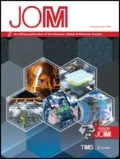Abstract
As ferroelectric device dimensions continue to shrink, the increasing ratio of boundary to bulk necessitates a thorough understanding of interfacial properties. Accordingly, the local piezoelectric hysteresis of a polycrystalline lead zirconate titanate thin film is quantitatively measured and compared to the separately measured grain orientation and the corresponding predicted residual stress and charge. The piezoelectric response is determined using a variation of atomic-force microscopy known as piezo-force microscopy, with which nearly 20 hysteresis measurements were acquired spanning four grain boundaries and five grains. The grain orientation in this region was determined by scanning-electron microscope using electron-backscattered diffraction.
Similar content being viewed by others
References
A. Gruverman et al., “Asymmetric Nanoscale Switching in Ferroelectric Thin Films by Scanning Force Microscopy,” Applied Physics Letters, 78(18) (2001), pp. 2751–2753.
Y. Kim et al., “Grain/Domain Interaction and Its Effect on Bit Formation in Ferroelectric Films,” Integrated Ferroelectrics, 78 (2006), pp. 255–260.
M. Alexe et al., “Switching Properties of Self-Assembled Ferroelectric Memory Cells,” Applied Physics Letters, 75(8) (1999), pp. 1158–1160.
A. Gruverman and A. Kholkin, “Nanoscale Ferroelectrics: Processing, Characterization and Future Trends,” Reports on Progress in Physics, 69(8) (2006), pp. 2443–2474.
V. Nagarajan et al., “Nanoscale Polarization Relaxation in a Polycrystalline Ferroelectric Thin Film: Role of Local Environments,” Applied Physics Letters, 86(26) (2005), pp. 192910–192913.
A. Pignolet et al., “Orientation Dependence of Ferroelectricity in Pulsed-Laser-Deposited Epitaxial Bismuth-Layered Perovskite Thin Films,” Applied Physics A—Materials Science & Processing, 70(3) (2000), pp. 283–291.
D.A. Bonnell and B.D. Huey, “Basic Principles of Scanning Probe Microscopy,” Scanning Probe Microscopy & Spectroscopy: Theory, Techniques, and Applications, ed. D.A. Bonell (New York: Wiley-VCH, 2001), pp. 7–42.
O. Kolosov et al., “Nanoscale Visualization and Control of Ferroelectric Domains by Atomic-Force Microscopy,” Physical Review Letters, 74(21) (1995), pp. 4309–4312.
S. Hong et al., “Principle of Ferroelectric Domain Imaging Using Atomic Force Microscope,” Journal of Applied Physics, 89 (2001), no. 2, pp. 1377–1386.
O. Auciello, A. Gruverman, and H. Tokumoto, “Scanning Force Microscopy Study of Domain Structure in Pb(ZrxTi1−x)O−3 Thin Films and Pt/PZT/Pt and RuO2/PZT/RuO2 Capacitors,” Integrated Ferroelectrics, 15(1–4) (1997), pp. 107–114.
S. Dunn et al., “Ultrahigh Resolution of Lead Zirconate Titanate 30/70 Domains as Imaged by Piezoforce Microscopy,” Nanotechnology, 13(4) (2002), pp. 456–459.
K. Franke et al., “Modification and Detection of Domains on Ferroelectric PZT Films by Scanning Force Microscopy,” Surface Science, 302(1–2) (1994), pp. L283–L288.
C.S. Ganpule et al., “Imaging Three-Dimensional Polarization in Epitaxial Polydomain Ferroelectric Thin Films,” Journal of Applied Physics, 91(3) (2002), pp. 1477–1481.
H. Shin et al., “Read/Write Mechanisms and Data Storage System Using Atomic Force Microscopy and MEMS Technology,” Ultramicroscopy, 91(1–4) (2002), pp. 103–110.
T. Tybell et al., “Domain Wall Creep in Epitaxial Ferroelectric Pb(Zr0.2Ti0.8)O−3 Thin Films,” Physical Review Letters, 89(9) (2002), http://prola.aps.org/abstract/PRL/v89/i9/e097601.
F. Zavaliche et al., “Polarization Switching in Epitaxial BiFeO3 Films,” Applied Physics Letters, 87(25) (2005), http://scitation.aip.org/dbt/dbt.jsp?KEY=APPLAB&Volume=87&Issue=25.
D. Damjanovic, “Ferroelectric, Dielectric and Piezoelectric Properties of Ferroelectric Thin Films and Ceramics,” Reports on Progress in Physics, 61(9) (1998), pp. 1267–1324.
B.D. Huey et al., “The Importance of Distributed Loading and Cantilever Angle in Piezo-Force Microscopy,” Journal of Electroceramics, 13(1–3) (2004), pp. 287–291.
D.P. Field, “Recent Advances in the Application of Orientation Imaging,” Ultramicroscopy, 67(1–4) (1997), pp. 1–9.
F.J. Humphreys, “Review—Grain and Subgrain Characterisation by Electron Backscatter Diffraction,” Journal of Materials Science, 36(16) (2001), pp. 3833–3854.
D.J. Prior et al., “The Application of Electron Backscatter Diffraction and Orientation Contrast Imaging in the SEM to Textural Problems in Rocks,” American Mineralogist, 84(11–12) (1999), pp. 1741–1759.
A.J. Wilkinson and P.B. Hirsch, “Electron Diffraction Based Techniques in Scanning Electron Microscopy of Bulk Materials,” Micron, 28(4) (1997), pp. 279–308.
R.E. Garcia, B.D. Huey, and J.E. Blendell, “Virtual Piezoforce Microscopy of Polycrystalline Ferroelectric Films,” Journal of applied Physics, 100(6) (2006), http://scitation.aip.org/dbt/dbt.jsp?KEY=JAPIAU&Volume=100&Issue=6.
B.D. Huey et al., “Challenges and Results for Quantitative Piezoelectric Hysteresis Measurements by Piezo Force Microscopy,” Microscopy and Microanalysis, 11(S-03) (2005), pp. 6–9.
Author information
Authors and Affiliations
Rights and permissions
About this article
Cite this article
Nath, R., García, R.E., Blendell, J.E. et al. The influence of grain boundaries and texture on ferroelectric domain hysteresis. JOM 59, 17–21 (2007). https://doi.org/10.1007/s11837-007-0004-9
Published:
Issue Date:
DOI: https://doi.org/10.1007/s11837-007-0004-9




